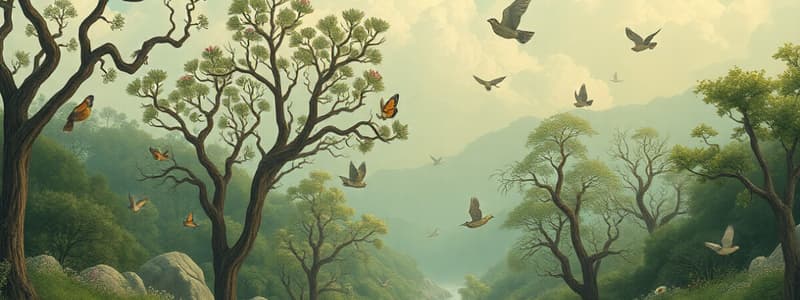Podcast
Questions and Answers
A population of deer lives in a forest. Which of the following scenarios would most likely lead to the deer population exceeding the forest's carrying capacity?
A population of deer lives in a forest. Which of the following scenarios would most likely lead to the deer population exceeding the forest's carrying capacity?
- An increase in the availability of water sources due to higher than average rainfall.
- A reduction in the amount of available sunlight reaching the forest floor.
- A disease outbreak that significantly reduces the deer population size.
- A decrease in the population of predators, such as wolves or coyotes. (correct)
Which of the following best illustrates how carrying capacity affects a population within an ecosystem?
Which of the following best illustrates how carrying capacity affects a population within an ecosystem?
- It forces the population to evolve rapidly to adapt to changing environmental conditions.
- It ensures the population grows exponentially without any checks or balances.
- It sets a maximum sustainable size that the population can reach, limited by available resources. (correct)
- It causes the population to continuously fluctuate randomly, without any predictable patterns.
In an environment with limited resources, what is the most likely long-term outcome when a population significantly exceeds its carrying capacity?
In an environment with limited resources, what is the most likely long-term outcome when a population significantly exceeds its carrying capacity?
- The population will experience a sharp decline due to resource depletion. (correct)
- The population will stabilize at a new, higher carrying capacity.
- The population will gradually adapt to the limited resources and thrive.
- The environment's carrying capacity will increase to accommodate the larger population.
A lake ecosystem has a carrying capacity of 1000 fish. Initially, the fish population is 500. After a period of abundant resources, the population grows to 1200. What is the most likely short-term effect on the lake ecosystem?
A lake ecosystem has a carrying capacity of 1000 fish. Initially, the fish population is 500. After a period of abundant resources, the population grows to 1200. What is the most likely short-term effect on the lake ecosystem?
A remote island has a stable ecosystem with a carrying capacity of 500 birds. A new, invasive species of bird is introduced. This new species competes for the same food sources and nesting sites as the native birds. What is the most likely long-term impact on the native bird population?
A remote island has a stable ecosystem with a carrying capacity of 500 birds. A new, invasive species of bird is introduced. This new species competes for the same food sources and nesting sites as the native birds. What is the most likely long-term impact on the native bird population?
Why is the availability of water a limiting factor for the size of an animal population in an ecosystem?
Why is the availability of water a limiting factor for the size of an animal population in an ecosystem?
How does shelter act as a limiting factor for animal populations in certain ecosystems?
How does shelter act as a limiting factor for animal populations in certain ecosystems?
Why are scorpions well-suited to desert environments?
Why are scorpions well-suited to desert environments?
Which of the following best explains how scorpions obtain the water they need to survive in the desert?
Which of the following best explains how scorpions obtain the water they need to survive in the desert?
How does burrowing under the sand help scorpions survive in the desert?
How does burrowing under the sand help scorpions survive in the desert?
Flashcards
Carrying Capacity
Carrying Capacity
The maximum number of organisms an environment can support.
Ecosystem
Ecosystem
A community of living things interacting in a specific area.
Limiting Factor
Limiting Factor
Something that restricts population size in an environment.
Food Availability
Food Availability
Signup and view all the flashcards
Water Availability
Water Availability
Signup and view all the flashcards
Water Supply
Water Supply
Signup and view all the flashcards
Availability of Shelter
Availability of Shelter
Signup and view all the flashcards
Scorpion
Scorpion
Signup and view all the flashcards
Burrow
Burrow
Signup and view all the flashcards
Study Notes
- Carrying capacity is the maximum number of living organisms an environment can support.
Ecosystems
- Scientists study carrying capacity to determine if an ecosystem is sustainable.
- An ecosystem is a community of animals, plants, and other organisms living in the same area.
- Ecosystems provide resources for animals to live, feed, and reproduce.
- An ecosystem can only support a certain number of animals before problems arise.
Limiting Factors
- Scientists evaluate limiting factors to determine how many animals can live in an area.
- A limiting factor restricts the number of organisms that can be supported.
- Availability of food, water, and shelter are limiting factors.
- A small forest can support two bears easily if there’s enough vegetation and berries.
- If four bears live in the forest, food will become scarce, reducing the carrying capacity to two bears.
- Lack of adequate water supply limits the carrying capacity of an environment.
- Deserts lack shelter from heat and wind, limiting the carrying capacity for animals like bears.
- Scorpions thrive in deserts because they eat insects and get hydration from their prey.
- Scorpions burrow under the sand for shelter from the sun and protection from predators.
Studying That Suits You
Use AI to generate personalized quizzes and flashcards to suit your learning preferences.
Description
Learn about carrying capacity, the maximum number of organisms an environment can support. Explore how ecosystems provide resources and how limiting factors like food, water, and shelter affect the number of animals that can live in an area sustainably.




